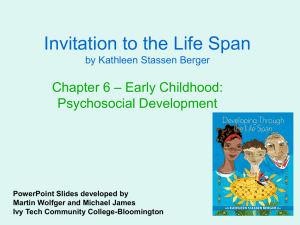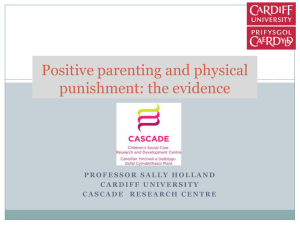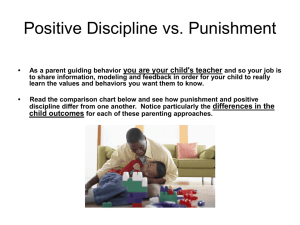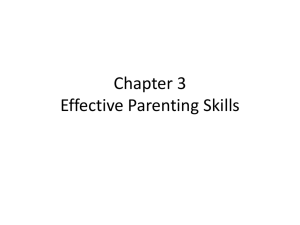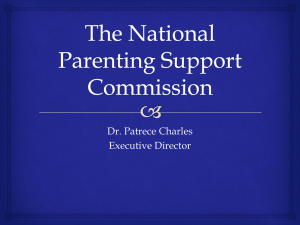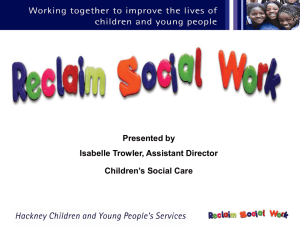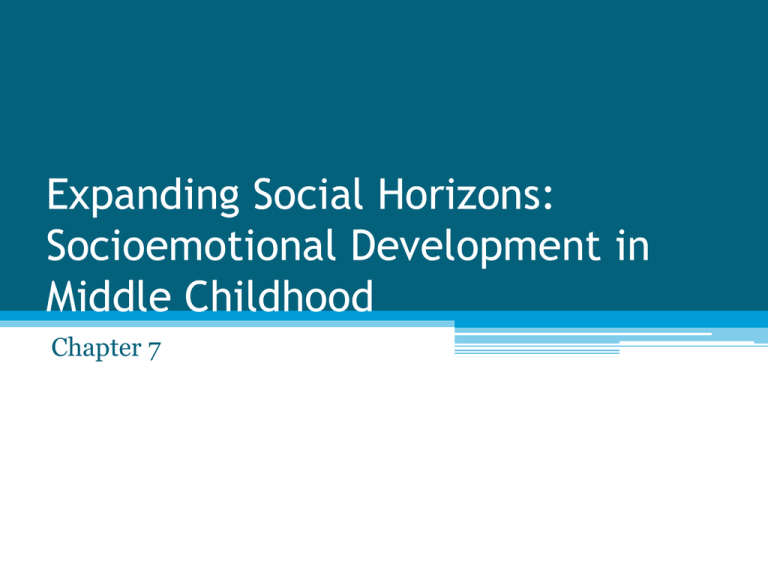
Expanding Social Horizons:
Socioemotional Development in
Middle Childhood
Chapter 7
Family Relationships
• Learning Objectives
• What is a systems approach to parenting?
• What are the primary dimensions of parenting?
How do they affect children’s development?
• What determines how siblings get along? How
do first born, later born and only children differ?
• How do divorce and remarriage affect children?
• What factors lead children to be maltreated?
The Family as a System
• Older views saw child development as primarily
the result of parent’s actions
• Current views, Systems View, of child rearing
view the family as a system with parents and
children affecting each other
• In addition, the family system is impacted by
outside influences such as extended family,
community, and even larger entities
Dimension and Styles of Parenting
• Parenting can be viewed through the dimension of
warmth and responsiveness and control
• -Children of warm parents feel secure, happy
• and are generally well behaved
• -Children of hostile or uninvolved parents may
• be anxious and less controlled
• Parenting can also be viewed involving control with
the controlling parent at one end and the uninvolved
parent at the other end of the spectrum
Intermediate amount of control is best.
Dimension and Styles of Parenting
• The dimension of control affects parenting
effectiveness
• -Children of over controlling parents may feel
• unable to develop standards of behavior on
• their own
• A balance of good control, communication, and
warmth results in children with an
understanding of what is expected and invites
dialogue
Parenting Styles
• Authoritarian parenting combines high control
with little warmth
• -Hard work, respect, and obedience are
• encourage.
• -Little give and take and parents do not explain
• their decisions
• Authoritative parenting combines moderate
control with warmth and responsiveness
• -Rules are explained and decision making is
• encouraged
Parenting Styles
• Indulgent permissive parenting provides warmth
and little control
• -Use little punishment and accept their
• children’s behavior
• Indifferent uninvolved parenting involves little
warmth or control
• -Parents not involved with their children
• -Basic physical and emotional needs met
• -Minimize their time with their children
• -Avoid becoming emotionally involved with the
child
Parenting Styles
• Styles of parenting have different effects on children’s
development
• -Authoritative parents
• -children tend to be more responsible, self•
reliant, and friendly
• -Authoritarian parents
• -children have low self-esteem and are less
•
skilled socially
• -Indulgent-permissive parents
• -Children are often impulsive and easily
•
frustrated, little self control
• -Indifferent-uninvolved parents
• -Children often have low self-esteem, are aggressive
•
impulsive and moody
Variations Associated with Culture and
Socioeconomic Status
•
•
•
•
•
•
•
•
•
European-American parents
-value warmth and moderate control in order
to encourage independence and self
reliance
Asian and Latin American parents
-individualism is not highly valued
-cooperation and collaboration is encouraged
with more emotional restraint and control
Lower social economic status leads to more
authoritarian styles
Parental Behavior
• What specific behaviors can parent’s use to
influence their children? Direct instruction,
modeling, feedback (reinforcement, punishment)
• Parents who use direct instruction tell children what
to do, and when and why
• -Most powerful when combined with modeling
• Learning by observation is
effective, especially if paired
with counterimitation, or
learning what should not be
done.
Parental Behavior
• Direct instruction , telling child what to do ,
when, and why is better than just telling them
what to do
• Parents can coach children in social skills such
as inviting a child over privately so as not to hurt
the feelings of those not invited
• Modeling is a powerful tool in teaching children
what is to be done as well as counterimitation –
teaching what not to do such as a child seeing
parent punish a sibling for bad behavior.
Feedback
•
•
•
•
•
•
•
•
•
Negative reinforcement trap
-a child cries, complains or whines until the
parent relents and provides what the child
desires
Punishment
-most effective when:
-immediate
-consistent
-informative (providing an explanation and a way
to avoid in the future
• -administered by a person with whom the child
• has a warm and affectionate relationship
Punishment
• Side effects and drawbacks
• -temporarily effective, suppressive
child does not learn new behaviors to
replace the bad behaviors
• Children upset by punishment, may not understand
the purpose of the consequences
• Physical punishment may result in aggression as a
means to resolve disputes with other children
• Physical punishment can result in mental health
problems, impaired parent-child relationships,
delayed cognitive development
•.
Punishment
• Time outs
• -brief, effective and informative, allows time to
calm down and then talk to child about why he
was punished and how to avoid future
punishment
Influences of the Marital System
• Chronic severe parental conflict is harmful to
children
• -Jeopardizes the child’s feelings of a stable
• family
• -Affects the parent-child relationship, parent may
use same style of resolving conflict with the child
• -Parents in conflict may be too preoccupied for
high quality parenting
• - Children are more prone to become anxious,
withdrawn, chronic illnesses
Influences of the Marital System
• When parents find mutually acceptable solutions
children respond positively to conflict
• Some parents don’t work well together, compete
for child’s attention,
• Some parents act as gatekeepers limiting the
participation of the other parent
Children’s Contributions: Reciprocal
Influence
• Children’s characteristics affect how parents
treat them
• -age
• temperament and behavior
Siblings
• As families grow, sibling relationships become
more complex
• -Toddlers talk more to mothers than older
• siblings
• -By 4 years old, children talk more to older
• siblings than their mothers
• -One effect of a sibling’s birth is that fathers
• interact more with older children
• A birth of another child is stressful and may
result in withdrawal or regression
Adopted Children
• 2-4% of U.S. children are adopted
• Adopted children are more likely to be prone to
conduct disorders and adjustment problems in
school
• -more likely the older the child’s age at the time
• of adoption
• -related to the quality of care before adoption
• Most adopted children do quite well
Impact of Birth Order
• First born children
• -Parents are enthusiastic but inexperienced
• -Parents are demanding and have high
expectations
• -The child often has a higher IQ scores, more
conforming and are more likely to go to
college
Impact of Birth Order
• Later born children
-Are less concerned about pleasing parents
-Are more popular with peers and more
innovative
• Only children
-Contrary to myth, are not spoiled or egotistical
-Succeed more often in school and have
higher levels of IQ, leadership, autonomy and
maturity
Divorce and Remarriage
• In the 1990s, 50%of all U.S. children experienced
their parents divorce
• After divorce, children tend to live with mothers
• Mothers were less affectionate with children in
• the first months after a divorce
• Parents are less able to control their children after a
divorce
• 2 years after a divorce, mother were more
affectionate and better able to discipline
• 6 years after divorce, mothers and daughters were
closer but mother and sons had greater conflict
What Aspects of Children’s Lives are
Affected by Divorce?
• Research show that school achievement,
conduct, adjustment, self-concept, and parentchild relations faired poorly compared to
children of intact families
• Adolescents of divorced parents are more likely
to become teen parents and to become divorced
themselves
• There is a small but significant increase in
emotional problems of adult children of divorced
parents
Impact of Divorce on Children
• Development may be affected by loss of a parent
role model, economic hardship, and parental
conflict
• Children are more affected during childhood and
adolescence than preschool or college age
• Children who are more emotional may be more
negatively impacted by divorce
• Reward with warmth, support, communication.
Parental cooperation and same sex custody are
positive in their impact
Blended Families
• More than 2/3 of divorced men and women
remarry, resulting in blended families
• While school age boys benefit from presence of a
stepfather, girls do not adjust well to their
mother’s remarriage
• Research on children living with a remarried
father is sparse. Usually results in behavior
problems, with children less likely to adjust well
Parent-Child Relationships Gone Awry:
Child Maltreatment
•
•
•
•
•
•
•
•
Physical abuse
-assault leading to physical injuries
Sexual abuse
-fondling, intercourse, or other sexual behavior
Psychological abuse
-ridicule, rejection or humiliation
Neglect
-inadequate food, clothing or medical care
Who are the Abusing Parents?
• Some countries culture does not allow for
physical punishment.
• -countries that allow spanking have a higher
• rate of maltreatment
• The stress of poverty and social isolation is
correlated with abuse
• Infants, preschoolers and frequently ill children
are more often abused
Effects of Abuse on Children
•
•
•
•
•
-Poor peer relations
-Do poorly in school
-Adults who were abused as children
-more depression and anxiety
-more likely to abuse their children
Preventing Abuse and Maltreatment
• -Reducing physical punishment
• -Social supports for parents
-allows for venting and advise
• -Counseling and parenting skills training
Peers
• Learning Objectives
• What are the benefits of friendship?
• What are the important features of groups of
children and adolescents? How do these groups
influence individuals?
• Why are some children more popular that
others? What are the causes and consequences
of being rejected?
• Why are some children aggressive? Why are
other frequent targets of aggression?
Friendships
• By 4-8 years, children single out specific peers as
playmates
• At 8 or 9, children have their first intimate and
reciprocal relationships
• Older children and adolescents emphasize
loyalty in friendships
• By about 14, friendships consist of intimacy and
support during stressful periods. Less
dependence on family
Who are Friends?
• -Same sexed, similar age, same race or ethnic
group
• -Similar interests, attitudes, recreation pursuits
• -Children with same sexed and opposite sexed
friends tend to be more popular, well adjusted
academically successful, and have higher self
esteem
Quality and Consequences of Friendships
• Children with good friends
-higher self-esteem
-less likely to be lonely or depressed
-engage in prosocial behavior
• Girl friends
-Rumination
-talking about each other’s problems
• Adults who had good friends as children
-experience greater feeling of self-worth
Groups
• Cliques
-tend to dress, talk and act alike
• Crowds
-affiliated with others with similar values and
attitudes
-some have more status and may impact selfesteem
-parenting style and involvement may have an
impact which crowd children affiliate with
Group Structure
• Often exhibit a dominance hierarchy with a
leader and followers
• Boys
-physical power is often the characteristic
associated with leadership
• Girls and older boys
-individual traits that relate to the group’s
main interest determine leadership
Peer Pressure
• -Irresistible pressure to conform to the group’s
norms
-most junior high and high school students
resist negative peer pressure
-most effective when standards are not clear
cut
-taste in music, clothing, smoking, drinking and
drug usage
Popularity and Rejection
• Popular children
-liked by classmates
• Rejected children
-disliked by classmates
• Average children
-liked and disliked but without as much
intensity
• Neglected children
-ignored by classmates
Consequences of Rejection
• Rejected children are more likely to:
-drop out of school
-commit juvenile offenses
-suffer from psychopathology
• Parental behavior
-imitation by the child of poor social skills and
conflict
-inconsistent punishment may result in
aggressive and antisocial behavior
Aggressive Children and Their Victims
• Instrumental aggression
-using aggression to achieve an explicit goal
• Hostile aggression
-unprovoked aggression used to intimidate and
harass, seen in elementary school
• Children’s tendency to behave aggressively is stable
over time, especially if seen at a young age, 1 and 2
yo use physical aggression
• Relational aggression –undermining others social
relationships,rumors
• Electronic bullying
Aggressive Children and Their Victims
• Chronic victims of aggression
-10% of elementary school age children and
adolescents
-children tend to be lonely, anxious, depressed,
and dislike school
-may be aggressive themselves or tend to be
withdrawn and submissive,
easily baited, overreact
Aggressive Children and Their Victims
•
•
•
•
•
•
Victims can be taught to deal with aggression
Not respond in kind
Not show fear
Increase self esteem
Help them foster friendships
Create a school climate that does not tolerate
bullying and supports victims
Outcomes of childhood Aggression
• Half of seriously aggressive 7 yo had committed
serious acts of delinquency by age 17
• 12 times more likely than less aggressive
children to be charged for criminal activity
• Leads to poor adjustment to high school. Failing
grades, dropping out, unemployment
Television: Boob Tube or Window to the
World?
• Learning Objectives
• What is the impact of watching television on
children’s attitudes and behavior?
• How does TV viewing influence children’s
cognitive development?
• How truthful are common criticisms of TV?
Influence on Attitudes and Social
Behavior
• Important contributor to the socialization of
north American children
• Research show frequent viewing of TV violence
increases aggressive behavior
• 8 year olds that were exposed to large amounts
of TV violence had more extensive criminal
records as 30 year old. Similar results were
found for violent video games
Influence on Attitudes and Social
Behavior
• Some shows teach language and reading skills
• Time watching Sesame Street predicts grades in
high school and time adolescents spend reading
• Teach academic and social skills
• Such shows are Arthur, Martha Speaks, Super
Why!, Mister Rogers’ Neighborhood
• Curious George, Sid the Science Kid, The
Dinosaur Train teach math and science
• Electric Company, 3-2-1-Contact, Square One
TV help learn academic and social skills
Stereotypes
• Some research suggests that exposure to TV may
promote the acceptance of gender, race, and
ethnic stereotypes by children
• Shows on TV do not accurately portray the
demographic texture of society. Minorities and
women may be under represented and gender
roles may be exaggerated
• Children who are heavy consumers of TV may
accept these misrepresentations as reality.
Consumer Behavior
• Preschool children
-perceive commercials as a form of
entertainment
• 8 or 9 year old children
-understand that commercials are meant to be
persuasive
-may not always be truthful
• Children are affected by advertising
-most ask parents to buy items seen of TV
Guides for Children and TV Viewing
• Parent should set absolute rules concerning
amount of TV to be watched
• Children should not watch TV out of boredom
• Adults should watch TV with children and
discuss programs
• Parent should model good TV viewing, avoiding
shows that are inappropriate for young viewers
Prosocial Behavior
• Children are more likely to act prosocially after
watching brief films in which peers acted
prosocially
• Programs such as Mr. Rogers Neighborhood
were found to be effective in encouraging
prosocial behavior, particularly in boys
• While these studies show that TV can promote
• prosocial behavior, children may not watch the
appropriate shows, which are limited in number
Influences on Cognition
• Studies show that shows such as Sesame Street
promote more proficiency as recognizing letters,
numbers, counting and vocabulary
• These studies confirm that TV can be a positive
influence on these abilities if parents promote
good viewing
Criticisms of TV
•
•
•
•
•
•
•
•
•
•
Two major criticisms:
-TV promotes short attention spans because of
high interest segments
-TV promotes passive, lazy thinkers who are
less creative
Findings
-No support for TV promoting short attention
spans
-Mixed findings on TV having negative impact
on thinking and creativity
Use of Computers
• Used for school assignments, play games,
communicate with peers, social media
• Amount of harm depends on games played, violent
games promote violence
• Games like Tetris, Star Fox emphasize perceptualspatial skills
• 10% of youths become addicted to games –
dominates their lives and produces a high much like
gambling addiction
• Online communication(ie facebook) can promote
self-disclosure and produce high quality friendships
Understanding Others
• Learning Objectives
• As children develop, how do their descriptions of
others change?
• How does understanding of other’s thinking
change as children develop?
• When and why do children develop prejudice
towards others?
Children’s Description of Others
• Goes through stages, concrete to conceptual
• Young children use concrete descriptors such as
appearance and possessions, and see people
more positively than negatively
• 8-14 yo begin to include psychological traits such
as funny or smart
• 16yo integrate traits and give more complex
descriptions such as describing how and when a
person is sarcastic
Selman’s Theory
• Children move through stages of development of
perspective taking, preoperational children are
egocentric, think others think as they do
• Children at higher stages of cognitive
development are at higher levels of perspective
taking
• Children who are more advanced in perspective
taking are more well liked by their
peers
Selman’s Stages of Perspective Taking
• Undifferentiated age 3-6, Children know that self
and others can have different thoughts and feelings
• Social-informational 4-9yrs, Children know that
perspectives differ because people have access to
different information, believe people think a certain
way because they do not have some information
• Self-reflective, 7-12-yrs. Children can step into
another’s shoes and view themselves as others do;
they know that others can do the same
Selman’s Stages of Perspective Taking
• Third-person, 10-15 yrs, Children can step
outside the immediate situation to see how they
and another person are viewed by a third person
• Societal, 14 to adult, Adolescents realize that a
third-person perspective is influenced by
broader personal, social, and cultural contexts.
Realize that many would think its silly to watch
TV on a sunny day
Prejudice
• When children learn that they belong to a particular
group, they learn prejudice ( more of an enhanced
view of their group that a negative view of others in
preschool and kindergarten)
• -decreases during elementary school
• -increases again in adolescence
• Children tend to view members of groups as more
homogenous that they really are
• Prejudice may be related to social status
• -the higher the status of the group, the more
• positive it is viewed
• -reduced by discussion and role play
Prejudice, How to Discourage
• Encourage friendly contact between different
groups
• Groups must be equal and not in competition
with each other
• Parents and teachers must model and reduce
prejudice
• Have groups work together toward common
goals, projects
• Have children play different roles
• Educate with stories of racism

